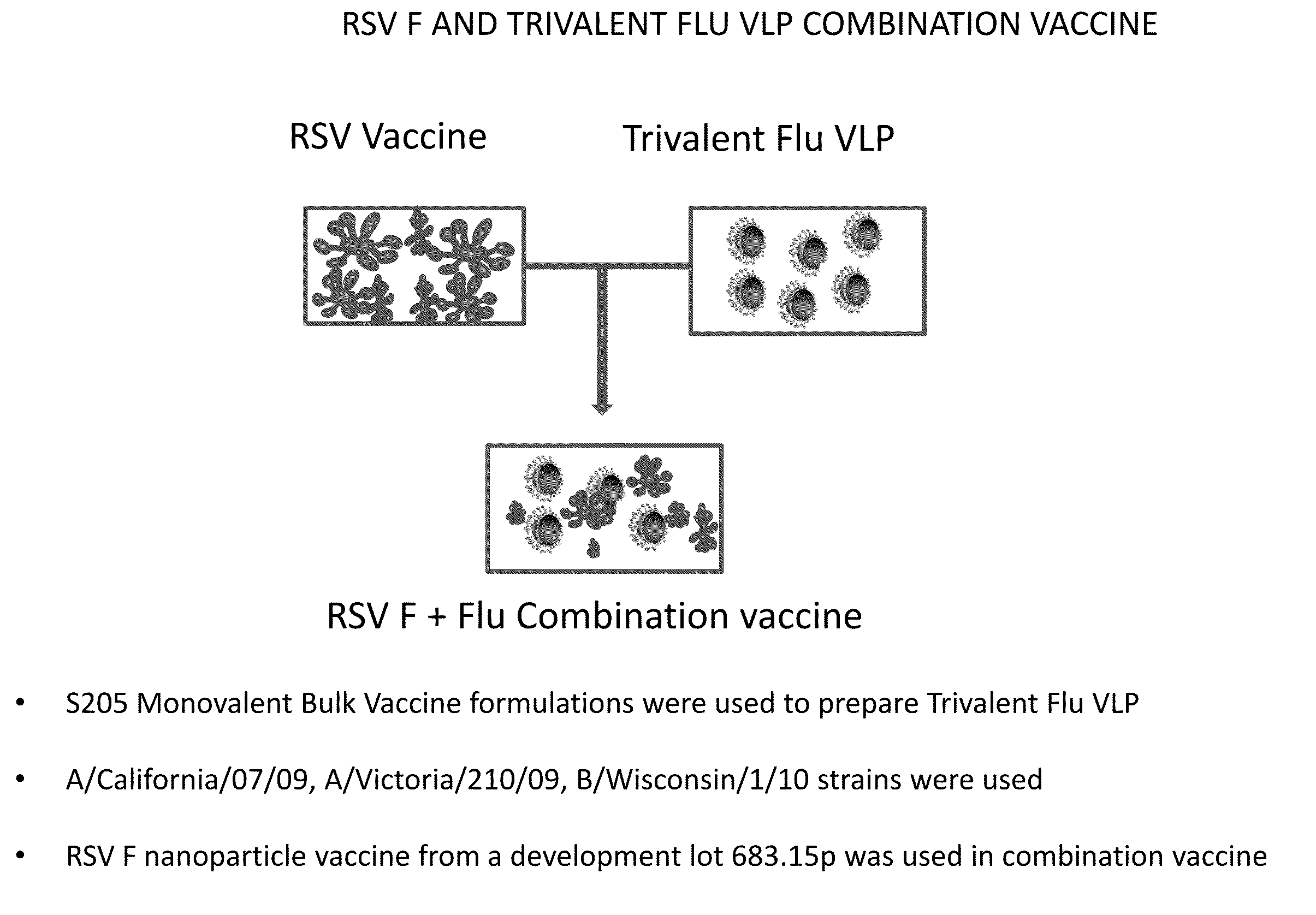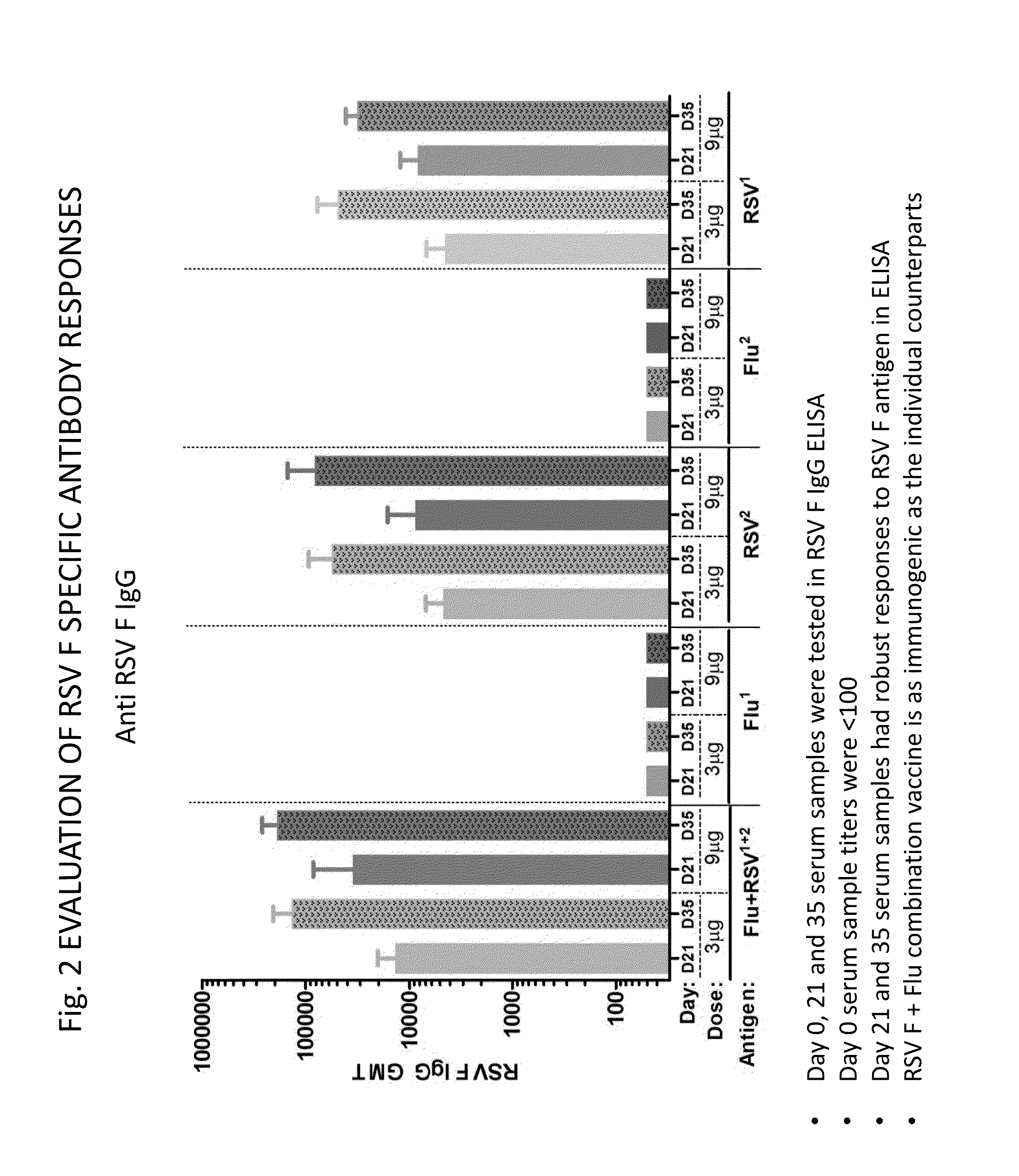Combination vaccine for respiratory syncytial virus and influenza
a technology of respiratory syncytial virus and conjugated vaccine, which is applied in the field of immunogenic compositions, can solve the problems of human morbidity and mortality, and achieve the effects of enhancing rsv f responses, well tolerated and immunogenic, and enhancing immune respons
- Summary
- Abstract
- Description
- Claims
- Application Information
AI Technical Summary
Benefits of technology
Problems solved by technology
Method used
Image
Examples
example 1
Mice Study
[0155]80 Balb / c mice age 6-8 weeks old were injected with candidate vaccines according to the protocol described in Table 1.
TABLE 1Study Design for Mice Trial with TrivalentFlu Component and RSV F componentTri-RSV FFluAntigenImmuni-MiceDoseDosezationGroupAntigen(N)(μg)(μg)DaysAnimal No.1Trivalent8330, 2112-0123-01 toFlu +12-0123-08RSV2Trivalent8990, 2112-0123-09 toFlu +12-0123-16RSV3Flu +83—0, 2112-0123-17 toBuffer 112-0123-24(Flu)4Flu +89—0, 2112-0123-25 toBuffer 112-0123-32(Flu)5RSV +8—30, 2112-0123-33 toBuffer 212-0123-40(RSV)6RSV +8—90, 2112-0123-41 toBuffer 212-0123-48(RSV)7Flu +83—0, 2112-0123-49 toBuffer 212-0123-56(RSV)8Flu +89—0, 2112-0123-57 toBuffer 212-0123-64(RSV)9RSV +8—30, 2112-0123-65 toBuffer 112-0123-72(Flu)10RSV +8—90, 2112-0123-73 toBuffer 112-0123-80(Flu)
[0156]Buffer 1 “Flu Buffer” contained 25 mM sodium phosphate buffer, pH 7.2, 500 mM sodium chloride, 0.3 mM CaCl2 and 0.01% w / v PS80. Buffer 2 “RSV Buffer” contained 25 mM phosphate, 0.15 M NaCl, 0.01%...
example 2
Characterization of RSV F Antibodies
[0159]Mice were administered combination compositions as described in Example 1. FIG. 2 shows the anti-RSV F response obtained as measured by ELISA assay. Day 0 titers were <100 (not shown). As expected the flu component alone did not induce an anti-RSV F response. Administering the RSV component alone resulted in a robust anti-RSV F response. Robust responses were obtained with Buffer 1 and Buffer 2 and at doses of 3 μg and 9 μg both at Day 35 (D35) and Day 21 (D21). Day 35 titers were higher. Remarkably, when the trivalent influenza component was combined with the RSV component, an elevated anti-RSV F response was achieved.
[0160]Similar data were achieved when the immune response was assessed to determine production of neutralizing antibodies. FIG. 3 shows neutralizing antibodies obtained in the trial described in Example 1. Neutralizing antibodies were measured at 35 days for each sample. Day 0 serum sample titers were <20 (not shown). Neutrali...
example 3
Characterization of RSV F Palivizumab-Competitive Antibodies
[0161]Palivizumab (Synagis™) is a monoclonal antibody that binds and neutralizes RSV viruses in humans. Palivizumab binds to an epitope on RSV F (SEQ ID NO:35). Advantageously, the RSV component stimulates an immune response against the same epitope. FIG. 4 is a palivizumab-competitive ELISA which shows that the antibody response induced by the combination composition binds to the same epitope recognized by Palivizumab. Day 0 serum titers were <20 (not shown). At Day 21 and Day 35 robust responses against the epitope were obtained with Buffer 1 and Buffer 2 and at doses of 3 μg and 9 μg. A similar response was obtained when the three flu components and RSV component were co-administered.
PUM
| Property | Measurement | Unit |
|---|---|---|
| pH | aaaaa | aaaaa |
| pH | aaaaa | aaaaa |
| temperature | aaaaa | aaaaa |
Abstract
Description
Claims
Application Information
 Login to View More
Login to View More - R&D
- Intellectual Property
- Life Sciences
- Materials
- Tech Scout
- Unparalleled Data Quality
- Higher Quality Content
- 60% Fewer Hallucinations
Browse by: Latest US Patents, China's latest patents, Technical Efficacy Thesaurus, Application Domain, Technology Topic, Popular Technical Reports.
© 2025 PatSnap. All rights reserved.Legal|Privacy policy|Modern Slavery Act Transparency Statement|Sitemap|About US| Contact US: help@patsnap.com



